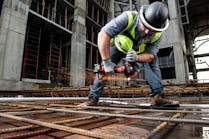The new normal has equipment asset managers focusing more finely on finances, as government spending at all levels continues to be unpredictable. Large fleets have, in general, maintained annual fleet-replacement plans, but they and their bosses review those plans more often and with less certainty about the future. Asset managers for other sizes of fleets have less flexibility and capital with which to work.
More 2013 Annual Report & Forecast
Construction outlook
Transportation
Water infrastructure
Home building
Remodeling
Nonresidential
Other management changes continue to be employed as the construction market remains flat compared to previous years. Fleets continue to extend machine lifecycles; engage rental machines to limit risk and comply with emissions regulations; and more closely monitor machine health through condition-based maintenance, telematics and fluid analysis programs.
Construction Equipment subscribers responded to this year’s survey of the industry as they did last year, hopeful for a rebound after a flat-to-down year.
Last year’s business year rating mirrored that of 2011: poor. The outlook for 2013 is slightly better, with the outlook tempered by how the optimism in recent years has not fully delivered in construction business results.
Environmental Responsibility
Equipment manager 40.2% Operations 15.5% Corporate compliance manager 7.4% Manager within eqt. dept. 2.2% Nobody has official responsibility 31.7% Don’t know 3%
Contract volume among Construction Equipment subscriber firms is again expected to rebound in the upcoming year, with the net expecting an increase. The percentage forecasting an increase in 2013 minus that forecasting a decrease is 19 percent, a substantial bump from previous years. Last year, the net was negative, at -5 percent, and fell short of the forecast of 12 percent.
The less-than-expected increases in contract volume only serve to bring caution to fleet asset managers as they consider fleet acquisition and maintenance strategies for 2013.
The new normal is uncertainty.
Construction equipment fleet trends
Fleet acquisition trends indicate the continued strength of short-term rental, with nearly one-fifth of fleet managers employing this strategy. The 19 percent reported in 2012 is slightly up from 17 percent reporting use of short-term rental in 2011. The net percentage of fleet managers who increased their use of short-term rental in 2012 was 7 percent (32 percent who used rental more often minus 25 percent who used it less), up from the net of 3 percent in 2011 (27 percent increased minus 24 decreased).
Acquisition Strategies
| Purchase outright | 47.1% |
| Purchase by financing | 36.1% |
| Short-term rental | 16.8% |
| Rental/purchase | 19.3% |
| Lease/purchase | 10.5% |
| Lease | 6.7% |
Larger jumps in the use of certain acquisition strategies occurred among managers who purchase equipment. The portion of those who say they purchase outright rose from 43 percent in 2011 to 47 percent in 2012. Also last year, 36 percent of fleet managers purchased equipment by financing it, up from 25 percent in 2011.
In a positive sign, overall fleet expansion increased last year. Although the 4 percent net (24 percent increasing fleet size minus 20 percent decreasing) fell short of the forecast net of 9 percent, it indicates the first year for expansion since 2009. The forecasts for 2013 fleet expansions leave a net of 7 percent. For perspective, fleet expansion recorded nets around 30 percent in the first half of the 2000s. In 2008, the final positive year, the net was 13 percent.
Fleet-replacement rates, which is the percentage of a fleet’s machines that are replaced in a year, were consistently near 10 percent in the years prior to the recession. In 2012, fleet managers reported a rate of 5.5 percent, higher than the expected 4 percent. The 6.8-percent rate forecast for 2013 machine replacement would be the highest since 2008, when the rate was 6.9 percent.
Overall fleet condition continues to decline, indicating most fleet managers are still unable to implement full fleet-replacement strategies. In 2011, 38 percent of fleets reported health as excellent or very good, and that dropped to 33 percent in 2012. About half the fleets consider themselves in good condition, and 18 percent (nearly one in five) report fleet health as fair or poor.





